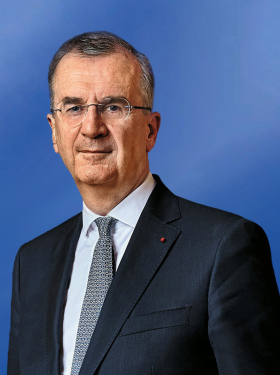- Home
- Governor's speeches
- Building tomorrow’s payments for Europe ...
Building tomorrow’s payments for Europe and beyond

François Villeroy de Galhau, Governor of the Banque de France
Published on the 16th of November 2023

Singapore Fintech Festival – 16 November 2023
Speech by François Villeroy de Galhau, Governor of the Banque de France
Ladies and Gentlemen,
I wish to thank my friend and colleague Ravi Menon very warmly for inviting me to speak at the Singapore Fintech Festival. I pay tribute to your twelve years as Managing Director of the MAS, and also to your excellent NGFS Chairmanship. Two years ago, Ravi gave one of his remarkable speeches here, centred on three characters from Greco-Roman mythology: Juno, Plutus and Mercury1. Today I will run through another part of this mythology, starting with Daedalus, the architect of a masterpiece that was built with a special purpose: to imprison and keep at bay the Minotaur – a half-bull beast with a thirst for blood.
Central banks are akin to Daedalus: they are the main architects of our current monetary and financial system. This system was designed to leave room for the private sector to innovate and develop activities that fit well into this global framework, both from an operational and regulatory point of view; this is why we central banks can be seen as the main, but not the sole architects. Our architecture is not set in stone: it has kept evolving, and is set to evolve further, keeping pace with the newest technologies.
And so far, we have been able to do so while avoiding monetary or financial instability, which is “our” Minotaur. Its mere existence had even been more or less forgotten. But the beast has been waking up recently, with the rise of stand-alone and insufficiently regulated financial innovations, among others. First-generation crypto assets, so-called “stablecoins” and DeFI have popped up one after the other; these wild constructions (although to varying degrees) have already led to excessive volatility, insufficient consumer protection, IT vulnerabilities, failures and insolvencies, and so forth, which may spread to the global financial system.
Shall the main architect order the destruction of these constructions, and forbid them from now on? Preferably not, but they need to be regulated and supervised properly2. This is a necessary condition for restoring trust and ensuring stability. As architects, we are also eager to build on their underlying distributed ledger technology (DLT), which offers clear benefits such as increased transparency and interconnectedness. We look forward to shaping our construction accordingly, so that it remains state-of-the-art, fluid and consistent with its environment.
Central banks are therefore, one might say, also doubly in charge of Ariadne’s thread, ensuring trust and creating new gateways so that anyone can find their way. Everybody knows Asia is tech-friendly, and that the Monetary Authority of Singapore (MAS) in particular is proactive in this regard. This is perhaps less known, but so are Europe and France. I will illustrate this concretely by recalling what the Banque de France and the Eurosystem have done so far, and the projects that are in our pipeline today, many of which relate to exploratory work on central bank digital currencies (CBDCs).
I will start with wholesale CBDC, where the Banque de France has been a pioneer by conducting twelve experiments since November 2020. We have explored all identified use cases on all types of DLT (public and private), with a wide range of public and private partners3. These experiments have shown that central banks will be able to steer the money supply of wholesale CBDC – which is essential to anchor the value of central bank money, and hence financial stability in the realm of tokenisation. We are testing various technologies in our experiments: we are improving our own DLT (DL3S), and in parallel we are exploring alternative protocols and blockchains – be they private or public.
The Banque de France is now also actively involved in the Eurosystem exploratory work on the settlement of tokenised assets in central bank money, which was launched last April4. With our DL3S technology, we are providing one of the three solutions that will be used over the course of 2024 in experiments and trials, the latter involving real transactions. The Eurosystem has already published the envisaged eligibility criteria and a survey5, before a formal call for interest that will take place in the coming weeks, and will roll out the experiments and trials over the course of 2024. Commercial banks and other financial actors will have a key role in the success of our exploratory work. In particular, I invite banks to take the opportunity of these experiments to explore “tokenised deposits”, for which the BIS has made a strong case. Recording these deposits on banks’ balance sheet would mean they would differ significantly from stablecoins. These tokenised deposits could potentially complement a wholesale CBDC.
This brings me to retail CBDC: after completing a two-year investigation phase, the Eurosystem recently launched the preparation phase that will lay foundations for a potential digital euro6. This “digital banknote” will have the same characteristics as existing cash: it will be accepted everywhere across the euro area thanks to its legal tender status;7 it will meet the highest privacy standards; and its basic functionalities will be free of charge for individuals8. In addition, the digital euro will bring complementary advantages compared with banknotes: it will allow the use of central bank money in e-commerce, in remote peer-to-peer payments, as well as for conditional payments, and will foster financial inclusion in the digital era.
Likewise, the digital euro will be distributed through banks: we are not, and will not become competitors to commercial banks. Once again, money shall remain a public-private partnership. But the trust commercial bank money inspires is anchored by its full equivalence and permanent convertibility, 1:1, to central bank money. Loosening this public anchor would sooner or later undermine trust; tokenised central bank money will provide the necessary “safety pivot”, and it will also act as a “‘platform for innovation”.9 The payment ecosystem as a whole will therefore benefit from it: the digital euro scheme we are developing will enable the emergence of open acceptance standards, fostering convergence and offering common ground on which to build further innovations. The private-sector led European Payments Initiative (EPI) with its pan-European Wero digital wallet payment solution will be able to take full benefit from it.
Turning now to a more global perspective, we are working hard on improving cross-border payments. It is one of the G20’s priorities to address their high friction costs, time lags, opacity and low accessibility. Central banks have built their monetary set-ups along similar principles around the world, but lack operational interoperability. The use of wholesale central bank money has the potential to address these issues, and in turn to improve cross-border payments.
- Over a short- to medium-term horizon, we are exploring the building of bridges between payment systems. Some projects could be implemented quickly, for instance the BIS’ Nexus which is aimed at enabling people to pay instantly across borders by connecting several fast payment systems from around the world (including Eurosystem’s TIPS).
- Longer-term and more global projects could pave the way for new avenues. The BIS10 and the IMF11 are actively thinking about integrated platforms, which would bring together tokenised central bank money, tokenised deposits and tokenised financial assets. In particular, the BIS’ blueprint for a unified ledger holds strong promises, as it would make CBDCs natively interoperable and would significantly ease cross-border payments. We look forward to playing our part in this project.
Meanwhile, we continue our experiments, together with the BIS, the IMF and national central banks. After the Mariana Project conducted under the aegis of BISIH, I am pleased to announce that the Banque de France will soon take part in the MAS’ Guardian Project. Our common experiment, “Les Gardiennes”, will deal with multi-CBDCs and potentially tokenised deposits in cross-currency and cross-border repos.
I will conclude with one of our contemporary architects, Frank Gehry, who was one of the very first to make use of computer capabilities in order to design iconic buildings. He once said “architecture should speak of its time and place, but yearn for timelessness”. This is precisely what we, central banks, are striving to achieve once more, together with private partners. Thank you for your attention.
1 Menon (R.), The future of money, finance, and the internet, speech, 9 November 2021
2 Please refer for instance to Villeroy de Galhau, F., Big techs in finance – a bildungsroman that is far from over, speech, 9 February 2023 and Regulation and innovation: the yin and yang of the financial sector, speech, 5 July 2023
3 Banque de France, Whole sale central bank digital currency experiments with the Banque de France, New insights and key takeaways, July 2023.
4 European Central Bank, Eurosystem to explore new technologies for wholesale central bank money settlement, press release, 28 April 2023.
5 European Central Bank, Survey n Eurosystem plans for trials and experiments on new technologies for wholesale central bank money settlement, 13 October 2023
6 European Central Bank, Eurosystem proceeds to next phase of digital euro project, press release, 18 October 2023
7 European Commission, Proposal for a Regulation on the establishment of the digital euro, 28 June 2023
8 Be it for account holding, payments or access to a mobile app.
9 Panetta, F., A digital euro: widely available and easy to use, speech, 24 April 2023
10 BIS Annual Economic Report, Chapter III. Blueprint for the future monetary system: improving the old, enabling the new, 25 June 2023
11 Adrian T., Mancini Griffoli T., The Rise of Payment and Contracting Platforms, IMF Fintech notes, 19 June 2023.
Updated on the 16th of November 2023